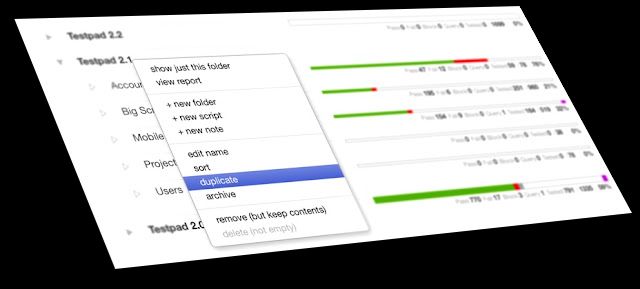Folders for Simpler Release Management

Folders for Simpler Release Management
Folders in Testpad allow you to re-use tests from old releases as an on-the-fly template for new releases, because you can copy tests without carrying over old results/

ith the recent success of the new folders feature, here's a usage pattern that lots of customers have adopted to handle releases. In essence, this pattern avoids using Templates and instead uses the previous release as an on-the-fly template for the new one. You can also copy just single scripts, but making a copy of a whole folder will make copies of all of its contained scripts – a very efficient way to prepare for your next release in just one click.
EDIT: Screenshots pre-date the big UI update in June 2018
Duplicate the previous release
- Right-click on the folder for the previous release and select Duplicate
- Edit the new folder name to reflect the new release version number

Update the tests
- Edit the new copies of the Scripts to catch up with the latest features in the product; adding new Scripts as required, and deleting any unneeded Scripts
Archive the old release
- (optional, depending on how tidy you like your Project view) Right-click the old release folder and select Archive; this puts the old folder in the Project's Archive tab. Note that this is different to archiving a whole Project which you do by right-clicking on the Project's name in the list on the left.
Do the testing
- Within each Script in the new release folder, and when the product is ready for testing, make the first test runs for the release, collecting lots of passes (hopefully) and a few fails (inevitable)
Share the progress
- Start sharing the folder report with stakeholders: from the Project view, right click on the folder name and select View Report. This opens the report in a new window. The contents and verbosity of the report can be configured using the button in the top-right corner, which is also where you can find the Enable Sharing button to get a share link. Alternatively, the whole report is easy to SaveAs because it is a single self-contained HTML document that can be archived as-is in your own systems (file sharing, wiki attachments, emails etc).
Retest new builds
- If a new build is coming, create ReTests of the complete Test Runs. Prepare ReTest columns using the prompt when a run is first completed, or by opening the Test Run Details dialog (hover over a Test Run header and click on the Edit icon that appears), sliding the slider to Complete if it's not already, and then clicking "start a retest".
A ReTest is different to simply pressing "new test run" in that the new column takes the place of the previous run, both visually and in the progress stats. Thus you don't clutter the screen with more and more old test runs (unless you like that!), and the progress bar for the Script (and in turn, the Folder it is part of) can approach 100% pass as the fails get re-tested as working. You can get old runs back on the screen with a right-click on the header of the latest test run.
- And repeating step 7 as many times as new builds need re-testing to ship the release.
Ship it!
Any questions, problems or feedback, just email stef@testpad.com
